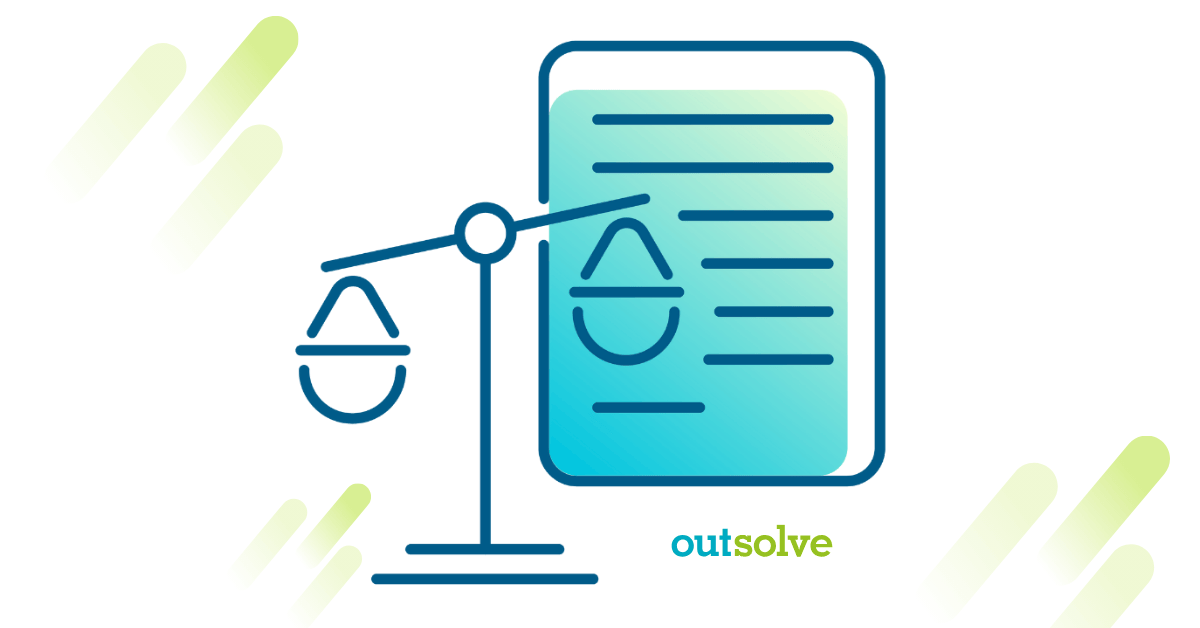8 min read
Adverse Impact vs Disparate Impact: Understanding the 2025 Compliance Shift
![]() OutSolve
:
May 27, 2025 11:16:34 AM
OutSolve
:
May 27, 2025 11:16:34 AM

In April 2025, a new Executive Order directed federal agencies to deprioritize enforcement actions based on disparate impact liability. This shift may reduce cases or pressure from the EEOC, but it doesn’t eliminate the legal or reputational risks your organization could face when policies result in unequal outcomes.
Disparate impact is still enforceable under Title VII, and many state laws continue to recognize it. Employers may still face legal challenges, especially if hiring, promotion, or layoff decisions result in unexplained disparities across protected groups. Financial repercussions can be high. In 2023, the Equal Employment Opportunity Commission recovered more than $45 million in monetary relief from systemic discrimination claims, many involving disparate impact cases.
As HR teams respond to this shift, many are working to understand the difference between adverse impact vs disparate impact. Though often used interchangeably, the terms relate to two different anti-discrimination processes. Adverse impact is the negative result of a neutral policy that has a discriminatory effect on applicants for a role. It is also typically the result of a proactive internal analysis conducted by an organization to identify potential risks. Disparate impact on the other hand is the legal result of an adverse impact. This legal theory can expose an employer to liability, even if the intent to discriminate wasn’t present.
Understanding the differences and similarities between adverse impact analysis and disparate impact liability helps HR teams apply the right tools at the right time—strengthening compliance, minimizing risk, and supporting fair employment practices.
What Is Adverse Impact Analysis?
Adverse impact analysis is a statistical tool used by employers to evaluate whether their employment practices disproportionately affect members of protected classes, such as race, gender, age, or disability status. It is not a legal finding of discrimination but a method to identify patterns that may signal compliance risks under federal anti-discrimination laws, including Title VII of the Civil Rights Act.
The goal of adverse impact analysis is to ensure hiring, promotion, and termination decisions rely on job-related criteria. It helps prevent unintentional exclusion of qualified candidates from underrepresented groups. This analysis is typically conducted using methods such as the impact ratio test—often called the “four-fifths rule”—or more advanced statistical significance testing to compare selection rates across demographic groups.
What exactly is the “four-fifths rule?” It is the selection rate (hiring rate) of a protected group compared to the group with the highest selection rate. If a protected group's selection rate is 80% of the highest rate, it could be considered evidence of adverse impact. For example, if 90 percent of male applicants pass a pre-employment test, but only 60 percent of female applicants do, the selection rate for women would be just 66 percent of that for men. This disparity could trigger a closer review, even if the policy appears neutral on its face.
Regulatory Requirements and Broader Use
Federal contractors are familiar with this process—it was a core requirement of affirmative action plans under OFCCP rules before the rescission of EO 11246. But adverse impact analysis extends beyond government compliance. Private employers often use this tool as part of broader risk management strategies to maintain equitable practices and avoid unintentional exclusion.
While the presence of statistical disparities does not in itself prove discrimination, it may indicate that a policy warrants further examination. Employers who identify potential adverse impact are expected to evaluate the business necessity of the policy and consider whether less exclusionary alternatives exist. The ability to demonstrate that a policy is both job-related and consistently applied is essential in defending against potential litigation or audit findings.
Timing and Strategic Application
Adverse impact analysis is most effective when conducted proactively and before making workforce changes or implementing selection procedures. When done correctly and with legal oversight, it can help organizations uphold anti-discrimination standards while preserving defensible, merit-based practices.
What Is Disparate Impact Liability?
Disparate impact liability is a legal doctrine that holds employers accountable for employment practices that, while facially neutral, disproportionately harm members of protected classes and cannot be justified by business necessity. The disparate impact definition, under Title VII of the Civil Rights Act, focuses not on intent, but on outcomes, specifically, whether a policy creates statistically significant disadvantages for certain groups.
A common disparate impact example is a minimum education requirement—such as a college degree for entry-level roles—that disproportionately excludes qualified candidates from underrepresented groups, despite not being directly tied to job performance.
Disparate impact liability is codified under Title VII and backed by landmark cases like Griggs v. Duke Power Co. (1971). It allows courts or agencies to hold employers accountable when neutral policies produce unjustified disparities. Unlike adverse impact analysis, which is a diagnostic tool used by employers, disparate impact liability is a legal determination made through investigation, litigation, or regulatory action.
It is important to note that Executive Orders cannot supersede law. Disparate impact theory still exists under Title VII of the Civil Rights Act. However, agencies have been instructed to de-prioritize cases based on disparate impact liability.
How Disparate Impact Claims Are Evaluated
A claim typically unfolds in three stages. First, the plaintiff must show that a specific employment practice causes a statistically significant disparity in outcomes across protected groups. If that threshold is met, the burden shifts to the employer to demonstrate that the policy is job-related and consistent with business necessity. Finally, even if business necessity is established, the employer may still face liability if alternative practices exist that are equally effective but less discriminatory.
Policies that may trigger disparate impact liability include cognitive tests, unnecessary degree requirements, or broad background checks. These requirements can disproportionately exclude certain demographic groups. Courts evaluate these practices not only by their intent but by whether their results can be defended under legal scrutiny.
Importantly, the presence of disparate impact alone does not mean an employer has violated the law. Liability depends on the employer’s ability to justify the practice and its willingness to revise or replace it if a less discriminatory alternative exists.
Post-EO Implications
While the 2025 Executive Order has instructed federal agencies to scale back enforcement of disparate impact liability, the doctrine remains part of federal law and is still enforceable through private litigation and state-level enforcement. Employers must therefore continue to monitor the real-world effects of their policies, even as the regulatory environment evolves.
Key Differences Between Adverse Impact Analysis and Disparate Impact Liability
Although often mistakenly used interchangeably, adverse impact analysis and disparate impact liability serve very different purposes. One is a risk assessment tool; the other is a legal finding with potential financial, reputational, and operational consequences. Understanding the distinction is critical for employers looking to reduce exposure while maintaining lawful, merit-based policies.
Prevention vs. Liability
Adverse impact analysis is a proactive, internal tool used to measure disparities in employment outcomes. It helps employers identify whether policies such as pre-employment tests or promotion criteria are resulting in selection rates that could raise questions under anti-discrimination laws. By identifying these issues early, organizations can modify or justify their practices before problems escalate.
Disparate impact liability, by contrast, is a legal consequence. It arises only after a policy is challenged, usually by a job applicant, employee, or enforcement agency, and shown to cause statistically significant disparities. The employer then bears the burden of proving that the policy is job-related and consistent with business necessity. If a less discriminatory alternative exists, the employer may still be held liable even if the policy serves a legitimate purpose.
Internal Analysis vs. External Legal Process
Adverse impact analysis is typically performed by HR professionals, compliance officers, or legal consultants. It is often used during policy design, hiring cycles, or layoff planning to evaluate risk before any legal action occurs.
Disparate impact liability is determined by courts, administrative judges, or regulatory agencies such as the EEOC or DOJ. It enters the picture only after an allegation is made and formal proceedings begin. Employers may also face disparate impact findings through private litigation or state audits.
Risk Management vs. Enforcement
Employers use adverse impact analysis to strengthen compliance programs, prevent unintentional exclusion, and demonstrate a commitment to fair employment practices. It is a forward-looking strategy that aligns with broader anti-discrimination efforts.
Disparate impact liability serves as a back-end enforcement mechanism. It penalizes policies that lead to unjustified discrimination, even in the absence of intent, and can result in costly settlements, mandated policy changes, or ongoing oversight through consent decrees.
Employers that clearly understand the differences between adverse impact analysis and disparate impact liability are better equipped to implement fair, merit-based policies while minimizing legal and reputational risk.
| Adverse Impact Analysis | Disparate Impact Liability | |
|
Purpose |
Internal assessment to identify risk of statistical disparities |
Legal determination of discrimination and remedy for unjustified disparities |
|
Initiated By |
Employer |
Plaintiff, regulator, or court |
|
Outcome |
Policy review or revision |
Potential liability, penalties, or injunctive relief |
|
Common Use |
Hiring audits, layoff planning, compliance programs |
Title VII lawsuits, EEOC investigations |
How the 2025 Executive Order Changes the Landscape
The Executive Order signed on April 23, 2025, Restoring Equality of Opportunity and Meritocracy, directs federal agencies to deprioritize enforcement actions based solely on disparate impact. In effect, the federal government will focus less on statistical disparities and more on intentional discrimination and merit-based employment decisions.
This does not mean disparate impact liability has been eliminated. Title VII remains in force, and private lawsuits and state laws still recognize and enforce disparate impact claims. Employers can still face legal risk if policies result in unjustified disparities, even without intent to discriminate.
Adverse impact analysis remains a critical tool, but it must be used carefully. Employers should avoid using demographic outcomes to drive decision-making and instead focus on validating that policies are job-related and consistently applied. Legal review is recommended to ensure analysis is protected and appropriately framed.
For HR leaders, this means shifting from federally driven compliance expectations to a broader risk management approach—one that accounts for state regulations, private litigation, and public perception, while continuing to uphold anti-discrimination standards.
Practical Compliance Recommendations for Employers
In today’s shifting regulatory environment, employers must remain focused on maintaining lawful, defensible, and merit-based employment practices. While federal enforcement of disparate impact has narrowed, the legal risks from state laws, private lawsuits, whistleblower claims, and internal employee challenges remain significant. The following strategies can help HR leaders mitigate exposure across legal, operational, and reputational dimensions:
Continue Running Adverse Impact Analysis Audits—But Do So Carefully
Use adverse impact analysis to assess selection rates for hiring, promotions, and terminations. These analyses help identify patterns that could trigger liability or audit scrutiny. Focus on validating job-related criteria, not adjusting outcomes, and when possible, conduct reviews under attorney-client privilege to protect sensitive findings.
This proactive approach can prevent adverse findings from escalating into reputational risk or regulatory inquiry.
Revalidate Employment Criteria
Review hiring tests, job descriptions, degree requirements, and other selection tools to ensure they reflect legitimate business needs. Criteria that are not clearly tied to performance can lead to disparate impact liability, especially if challenged in court.
Enterprise employers with large applicant pools are particularly vulnerable to class-action claims if outdated or non-essential qualifications disproportionately screen out protected groups.
Monitor State and Local Regulations
Many states continue to enforce disparate impact liability and have expanded anti-discrimination protections beyond federal requirements. Multi-jurisdictional employers must account for differences in state law to avoid inconsistent practices, and potential compliance failures, in high-risk states like California, Illinois, or New York.
Overlooking local enforcement can lead to costly fines, public scrutiny, or disruption of business operations.
Document Business Justifications
If a policy results in statistical disparities, be prepared to show how it supports a legitimate operational objective. Maintain documentation such as validation studies, job analyses, and decision rationales.
In high-stakes audits or class-action lawsuits, clear records can be the difference between fast resolution and prolonged legal exposure.
Avoid Race-Conscious Corrective Measures
The current enforcement climate discourages race- or gender-based adjustments to decision-making. Policies perceived as preferential can invite reverse discrimination claims, damage internal morale, or spark reputational backlash.
Focus on eliminating structural barriers and applying consistent, neutral evaluation methods that support both fairness and legal defensibility.
Work with Legal and Compliance Experts
Navigating the post-EO environment requires careful alignment between merit-based practices and anti-discrimination obligations. Partner with legal counsel or a compliance provider like OutSolve to conduct audits, assess adverse impact, and reinforce defensible practices.
For enterprise organizations and federal contractors, a strong compliance foundation also protects against contract risk, public reporting issues, and leadership accountability challenges.
Staying Compliant in a Post-EO Landscape
The 2025 Executive Order may have reduced federal emphasis on disparate impact enforcement, but the legal exposure hasn’t disappeared. State regulations, private litigation, and internal scrutiny still require employers to ensure that employment decisions are both fair and defensible.
Adverse impact analysis remains a valuable tool—but it must be used strategically. The priority is validating that selection processes are job-related and consistently applied, not adjusting outcomes based on demographics.
OutSolve helps HR leaders navigate today’s shifting compliance landscape. We clarify how and when to evaluate adverse impact vs disparate impact—and how to act on the results. Connect with us today to review your policies and prepare for what’s ahead.
Founded in 1998, OutSolve has evolved into a premier compliance-driven HR advisory firm, leveraging deep expertise to simplify complex regulatory landscapes for businesses of all sizes. With a comprehensive suite of solutions encompassing HR compliance, workforce analytics, and risk mitigation consulting, OutSolve empowers organizations to navigate the intricate world of employment regulations with confidence.
Weekly OutLook
Featured Posts

The Federal Government Shutdown Lingers: HR Professionals Take Action

HR Planning: 5 Planning Steps for Q4
Related Posts

Federal Contractor Compliance: What HR Teams Need to Budget For in 2026
2026 is quickly approaching, and HR professionals working in federal contractor organizations have more than just recruiting goals, engagement...

CHRO Survival Guide: Talent, Culture, and Leadership: How CHROs Can Thrive in Uncertain Times
In Part 2 of our CHRO Survival Guide series, we explored the costs of deregulation, the intensity of I-9 and E-Verify enforcement, and the impact of...

The Federal Government Has Reopened: What’s Next for Federal Contractors
As non-essential government offices reopen, human resources, EEO, and compliance professionals in government contractor workplaces may want to...
![[OTSLV]-BLOG-interior images-How to Avoid I-9 Penalties and Fines (1)](https://www.outsolve.com/hs-fs/hubfs/%5BOTSLV%5D-BLOG-interior%20images-How%20to%20Avoid%20I-9%20Penalties%20and%20Fines%20(1).png?width=600&height=314&name=%5BOTSLV%5D-BLOG-interior%20images-How%20to%20Avoid%20I-9%20Penalties%20and%20Fines%20(1).png)

